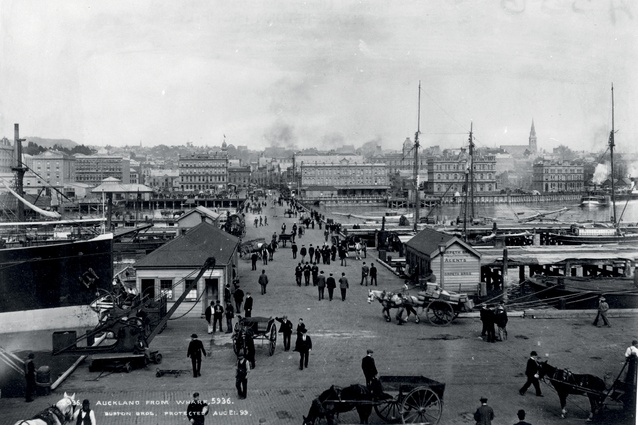Opinion: Bill McKay
Bill McKay on Auckland’s proposed port extension on behalf of the Auckland Architectural Association.

Since the water lapped the Auckland foreshore in 1840, at Fort Street, there has been a phenomenal filling in of our city’s waterfront. That flat land around Britomart was once a bluff on which Auckland’s first church stood, Beach Road was a beach and Commerce Street was Commercial Bay. Freemans Bay and Mechanics Bay have completely disappeared. The euphemism ‘reclamation’ has seen the acquisition and filling-in of harbour for 4.5 kilometres, from Westhaven to Judges Bay and extending, at its greatest, a kilometre out to sea.
Of course, the port was once the bustling heart of a young city but the wharfs were long fingers that extended outwards to berth ships and ferries and we all had access on a much more everyday basis. Famous photographs of Queen Street show it extending out into the harbour and filled with people travelling, transporting goods, trading, working or just watching the world go by. The rot set in with the filling in of those finger wharfs to create vast acreages of asphalt that extended well out into the tidal stream, such as the tank farm and container terminal, that are off-limits to Aucklanders. This development was driven by a notion of progress, at the expense of the environment, which characterised much of Auckland’s growth in the 20th century. This has wrecked the natural character of our beautiful harbour setting and given us the second-rate dump we live in today. What is hard to believe is that the same thing continues in 2015.
The port of the past, although we look back nostalgically on its physical character, was primarily a place of business but times change, the values of our society change and so too should business practice. It is time for a total re-evaluation of the presence of the port in the heart of Auckland. Does it make sense to utilise vast acreages for stacked containers, stored cement, parked cars and ripening bananas? Is this the kind of working waterfront envisaged by urban designers on plans signed off by Council? Does it make sense to have a cargo interchange, given Auckland’s awful transport infrastructure, right in the heart of a metropolis when many of the goods head out to the wider region? Containers landed in Tauranga or Whangarei could have just as good a chance of travelling rapidly to north and south Auckland on rail links as they would via that queue of diesel trucks clogging Auckland’s roads and motorways. Auckland has experienced civic amalgamation of local authorities on a massive scale in the name of efficiency. Why not look at the northern North Island’s ports and other infrastructure operation the same way?
The main problem with the Port is that, while our Council owns it, it is kept at a distance through the mechanism of the government-imposed Council Controlled Organisation structure and, in particular, that intermediary, Auckland Council Investments Limited. This has ensured the business side of the waterfront has virtually no democratic control or oversight and is run by unelected directors, in the Port’s own interests, with little regard for wider issues. And what businesses in this day and age are allowed to operate with open slather in the way the Port does? The harbour is public property but the port company takes it for its own use. In exchange for our water, our airspace and our views, it treats it like a heavy industrial site in the hinterlands and dumps untreated stormwater in the harbour and produces gas emissions, noise and traffic. There are smarter ways to organise things and plenty of overseas ports can show us how but the Council’s hands-off governance is our primary problem.
In relation to this year’s issue, the Port argues that it has a resource consent for the two finger wharf extensions but it is doing what every other sharp operator does under the Resource Management Act: making incremental under-the-radar gains that will add up to a significant adverse cumulative effect on our city, our harbour, our city and our environment. The company fully intends to fill the acres between those extensions. The Port’s old-fashioned approach to its role and presence compels us to re-think its place in a 21st-century city striving to be one of the best in the world in which to live. Car import and container operations need to be reduced radically or moved elsewhere, but tourism should be retained and there are innovative solutions to berthing bigger cruise ships. Dig out some of that ‘reclaimed land’ at the south end of the wharf and bring the water and the ships closer to town where they used to be. Get rid of Quay Street as a waterfront traffic artery, just as other waterfront cities in the world are doing. Or park cruise ships down by the tank farm where the Wynyard Quarter is seeing major (and well-planned) change and cafés, shops and hotels are springing up. String it all together with a light-rail tram-like link along the waterline from Westhaven to Britomart and further afield.
Designers solve problems of conflicting activities and aspirations such as we have here. The population of Auckland has seen the future and is ready for change. The new pressure group, Urban Auckland, is leading the charge for change. It is time for us as designers to step up and suggest solutions that accommodate the needs of all Aucklanders and avoid more loss of our harbour.










